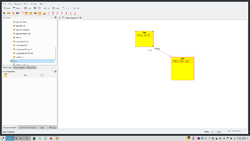Umbrello: Difference between revisions
mNo edit summary |
(Marked this version for translation) |
||
| Line 49: | Line 49: | ||
Or in other words, when you can use '''Umbrello''' for developing and improving itself. | Or in other words, when you can use '''Umbrello''' for developing and improving itself. | ||
== Tips and Hints == | == Tips and Hints == <!--T:11--> | ||
<!--T:12--> | |||
[[Special:MyLanguage/Umbrello/FAQ|Umbrello FAQ]] | [[Special:MyLanguage/Umbrello/FAQ|Umbrello FAQ]] | ||
Revision as of 05:30, 26 November 2012
 |
Umbrello UML Modeller is a Unified Modelling Language (UML) diagramming tool from KDE |
UML allows you to create diagrams of software and other systems in a standard format called Unified Modelling Language i.e. UML (www.uml.org).
Content of diagrams can be exported into code. Existing code files can be parsed and imported to be used in diagrams.
The following diagram types are supported:
- use case diagram
- class diagram
- sequence diagram
- collaboration diagram
- state diagram
- activity diagram
- component diagram
- deployment diagram
- entity relationship diagram
The Umbrello home page is at uml.sourceforge.net.
The source code can be found on websvn as part of the kdesdk package.
Screenshots are found on this page.
Mailing lists are:
Vision
Umbrello is in a good state, when you are able
- to parse its source code,
- to draw diagrams and explore its architecture, classes and code
- make changes to it
- and generate the code again out of its model, so that you are ready to compile it again.
Or in other words, when you can use Umbrello for developing and improving itself.
